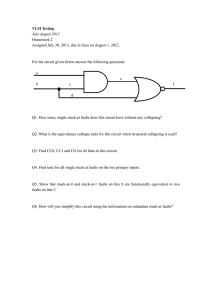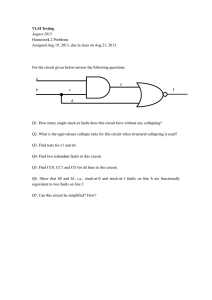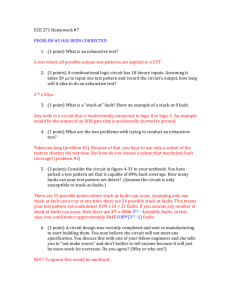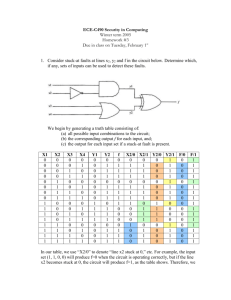-------------------------------------------------------------------------------------------- 1. What is the total number of single stuck-at faults... Answer the following questions, selecting just one answer per question.
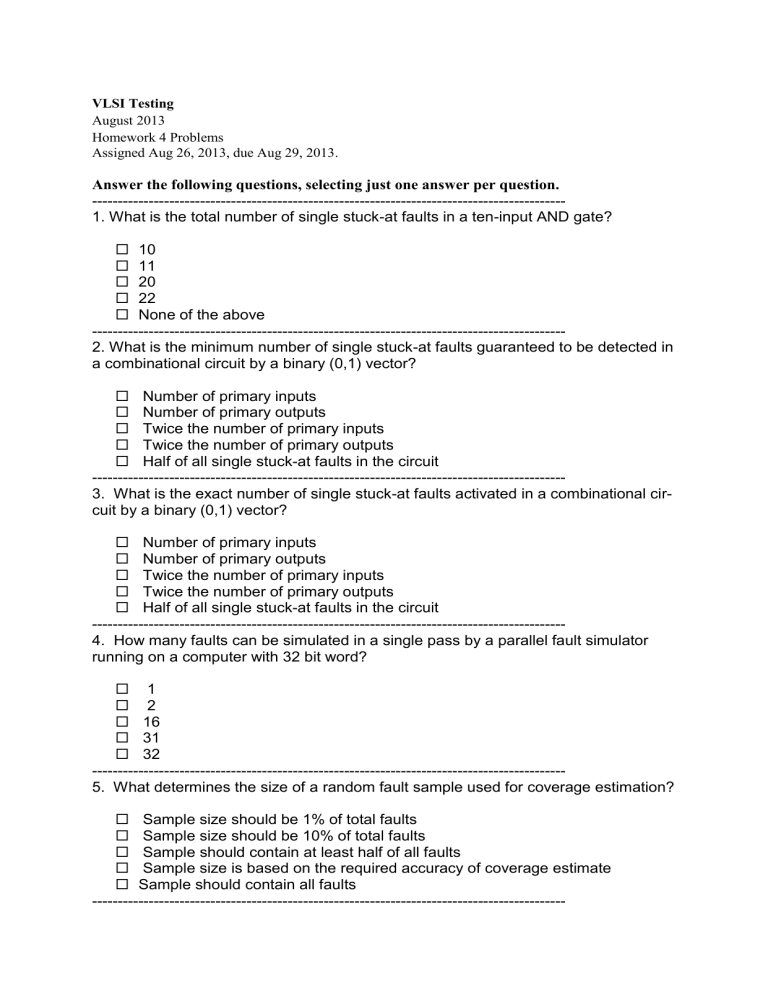
VLSI Testing
August 2013
Homework 4 Problems
Assigned Aug 26, 2013, due Aug 29, 2013.
Answer the following questions, selecting just one answer per question.
--------------------------------------------------------------------------------------------
1. What is the total number of single stuck-at faults in a ten-input AND gate?
10
11
20
22
None of the above
--------------------------------------------------------------------------------------------
2. What is the minimum number of single stuck-at faults guaranteed to be detected in a combinational circuit by a binary (0,1) vector?
Number of primary inputs
Number of primary outputs
Twice the number of primary inputs
Twice the number of primary outputs
Half of all single stuck-at faults in the circuit
--------------------------------------------------------------------------------------------
3.
What is the exact number of single stuck-at faults activated in a combinational circuit by a binary (0,1) vector?
Number of primary inputs
Number of primary outputs
Twice the number of primary inputs
Twice the number of primary outputs
Half of all single stuck-at faults in the circuit
--------------------------------------------------------------------------------------------
4. How many faults can be simulated in a single pass by a parallel fault simulator running on a computer with 32 bit word?
1
2
16
31
32
--------------------------------------------------------------------------------------------
5. What determines the size of a random fault sample used for coverage estimation?
Sample size should be 1% of total faults
Sample size should be 10% of total faults
Sample should contain at least half of all faults
Sample size is based on the required accuracy of coverage estimate
Sample should contain all faults
--------------------------------------------------------------------------------------------
Page 2 of 4
6. What does the symbol “D” mean in the five-value algebra used in test generation algorithms?
Don’t care
Same signal value in fault-free and faulty circuits
Different signal values in fault-free and faulty circuits
Logic 1 in fault-free circuit and logic 0 in faulty circuit
Logic 0 in fault-free circuit and logic 1 in faulty circuit
--------------------------------------------------------------------------------------------
7. For testing a ten-input AND gate, find a single test vector that will detect the largest number of single stuck-at faults?
0000000000
0101010101
0011001100
0000011111
1111111111
--------------------------------------------------------------------------------------------
8. For a ten-input AND gate, what is the minimum number of test vectors that will detect all single stuck-at faults?
1
10
11
22
1024
--------------------------------------------------------------------------------------------
9. What is the sequential depth of a circuit?
Number of logic gates in the circuit
Total number of flip-flops
Number of logic gates plus the number of flip-flops
Maximum number of flip-flops on a primary input to primary output path
None of the above
--------------------------------------------------------------------------------------------
10. What is the maximum number of vectors that may be needed to detect a single stuck-at fault in a cycle-free synchronous sequential circuit?
2 n vectors where n is the number of primary inputs in the circuit
Vectors may equal total number of flip-flops
One vector more than the sequential depth
Maximum number of flip-flops on a primary input to primary output path
None of the above
--------------------------------------------------------------------------------------------
11. What is the critical path of a synchronous sequential circuit?
Path with largest number of gates
Combinational path with longest delay
Path that is easiest to sensitize
Path that is most difficult to sensitize
Any path that can be robustly tested for delay fault
Page 3 of 4
--------------------------------------------------------------------------------------------
12. What is the number of transition delay faults in a circuit?
Number of paths in the circuit
Same as the number of collapsed single stuck-at faults
Same as the number of uncollapsed single stuck-at faults
Number of gates in the circuit
Number of flip-flops in the circuit
--------------------------------------------------------------------------------------------
13. What should be the complexity of a memory test sequence for an n -bit memory?
O( n )
O( n 2 )
O( n 1.5
)
O( n log n )
Exponential in n
--------------------------------------------------------------------------------------------
14. What does a memory contains after completion of the MATS+ test sequence:
{ ↕ (w0); ↑ (r0, w1); ↓ (r1, w0) } ?
Alternating 0-1 pattern
Random bits
All 1’s
All 0’s
0’s in half lower order addresses and the rest 1’s
--------------------------------------------------------------------------------------------
15. The testing of analog circuits requires:
Test of stuck-at faults
Test of path delay faults
Measurement of resistors and capacitors
Current and voltage measurements
Verification of the circuit’s functional specification
--------------------------------------------------------------------------------------------
16. The essential minimum number of test pins added for scan design is:
1
3
Number of flip-flops
Log (Number of flip-flops)
None
--------------------------------------------------------------------------------------------
17. How many clock cycles will the testing of a scan circuit with 10,000 scan flip-flops and 1,000 combinational vectors will take:
1 million
1 billion
1,000
10,000
10,021,004
Page 4 of 4
--------------------------------------------------------------------------------------------
18. What are the principal benefits of scan design?
High fault coverage
Reduced test time during manufacturing
Reduced test generation complexity and high fault coverage
Faster circuit speed
No hardware overhead for improved testing
--------------------------------------------------------------------------------------------
19. An n -stage linear feedback shift register (LFSR) with primitive feedback polynomial generates:
All n -bit patterns in random order
All n -bit patterns in random order except the all-0 pattern
All integers from 0 to 2 n – 1 in ascending order from 0
All integers between 0 and 2 n – 1 in ascending order ending at 0
Only few selected patterns
--------------------------------------------------------------------------------------------
20. The aliasing probability for a signature analyzer constructed with an n -stage linear feedback shift register (LFSR) with primitive feedback polynomial is given by:
0.0
0.5
Reduced test generation complexity and high fault coverage
2
– n
1/ n
--------------------------------------------------------------------------------------------
